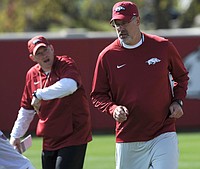ANDERSON, Mo.
Never let a little thing like a 90 percent chance of rain get in the way of a good float trip.
Indian Creek
Indian Creek forms in Newton County, Mo., and flows about 30 miles before joining the Elk River west of Pineville, Mo. The stream is mostly Class I and family friendly. It’s an excellent waterway for canoeing, kayaking and fishing. There are no major rapids. The river twists quite a bit. Limbs can be obstacles. Scenery ranges from forests to fields.
Information: Indian Creek Campground, 417-845-6400.
Source: Southwest Paddler
Not just rain, heavy rain. That was the forecast for the day Russ Tonkinson and I set aside to float Indian Creek, a jewel of a stream that meanders through Southwest Missouri.
Spirited debate erupted the day before departure. To go or not to go was the question.
It might rain all day. The river could flood.
Or maybe 90 percent meant storms in the afternoon. We'd be finished before the deluge.
"It's only a 4-mile float. If it gets nasty we can paddle on in," Tonkinson said. Plus, we'd get some money's worth out of our rain gear.
Our decision: Heck, let's go.
A beeping 5:30 a.m. alarm brought a pleasant surprise. I stepped outside to see twinkling stars and the moon shining through thin clouds. So far, so good.
I headed over to Tonkinson's place early. We were on the road to Indian Creek by 7:30 a.m. The gorgeous stream was just up the highway near Anderson, Mo. The fact that the stream is full of smallmouth bass had us revved. Clouds thickened and we waited for rain to pelt the windshield on the drive up Interstate 49 this morning in late July. It never happened.
Our game plan was to float 4 miles of Indian Creek upstream from Anderson. We were on our way to Indian Creek Campground, situated right on the river bank. Before our trip we'd arranged to meet Gina Redmon, campground owner, so she could ride with us upstream to our put-in spot. We'd start our trip, and Gina would drive the car back to the campground where our float would end.
The county gravel road follows the creek most of the way and the three of us enjoyed the scenery. One thing was lacking. Water. Indian Creek looked low enough in spots that it would be hard to get your sneaker soles wet. This may be the lowest water yet for Tonkinson and I to float Indian Creek.
We arrived at the big-rock put-in, cleverly named by Tonkinson and me for a garage-sized boulder at the access. We quizzed Gina about access spots farther upstream, for future reference.
"You can start higher up, but when it's this low I wouldn't put in farther upstream than here," she advised.
A little trail of dust followed the car when she headed back to the campground.
Rough Access
Big-rock put-in isn't exactly smooth launching. It requires sliding the canoe and gear about 10 feet down a gnarly bank to the water. It's a Class III access on a Class I river that's easy for anyone to navigate.
Fishing gear, paddles and lunch were finally in the canoe, but we had one more chore before shoving off. That is, to pick up any litter at the access. It's the right thing to do. Plus, it always increases our karma with the fish.
Easy current cradled the canoe like a gentle hand and carried us downriver. The low sky reminded us of that 90 percent.
"This is nice," Tonkinson said. "If it stays cloudy all day, the fishing could be great."
We drifted into the first sizable pool, where Tonkinson's rod bent first. "I'm snagged, dang it. Oh wait, it's a fish."
Whatever was on the hook had to be a trophy. Line sliced the water like a band saw and the fish showered the canoe in spray when it surfaced.
"Look at that! He's going crazy," Tonkinson hollered.
The fish he swung aboard was a 13-inch smallmouth that fought like a fish twice its size. No wonder lots of anglers testify that smallmouths are their favorite fish.
Tube baits in shades of dark green are the only lure a fisherman needs on Indian Creek and any other Ozark stream. Buzz baits are handy for top-water fishing, but the smallmouths ignored our buzz baits on this fishing float. Six-pound-test line is standard equipment for stream fishing in the Ozarks.
We caught the occasional smallmouth and other fish, but the catching was slower this trip than most. Shoot, sometimes we'd go a whole 15 minutes without catching anything. Picking up litter really works.
Pedestrian Paddlers
River rats can look at low-water floating two ways. It's a pain to get out and walk the boat. Or, it's an opportunity to stretch the legs and cool the feet. We walked about eight times and welcomed the wading.
In the years we've been floating Indian Creek, I don't recall Tonkinson and I ever seeing another boat. These clear, flowing waterways right in our backyard, like Indian Creek, got us talking about other nice things going for us here in our corner of the Ozarks.
"There are a lot of new, manmade things around here, but these streams were here before any human ever arrived," Tonkinson said.
Big rigs rumbled across the twin Interstate 49 bridges above us. The freeway means the take-out is close. Lovely Indian Creek meandered beneath a leafy canopy of summer green. We drifted and fished the last half-mile to the campground.
By trip's end, we'd boated about 40 fish including smallmouth bass, Ozark bass and sunfish. We lashed the canoe to the car top, relaxed for a spell at a picnic table, then bid farewell to Indian Creek.
Out on the highway, rain began to fall.
Outdoors on 09/18/2014


